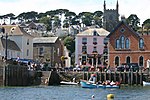Gribben Head

Gribbin Head (Cornish: an Gribyn) is a promontory on the south coast of Cornwall, England, UK, owned and managed by the National Trust. It separates St Austell Bay from the estuary of the River Fowey and is marked by a large tower used to aid navigation of ships approaching the local harbours. The nearest town is Fowey. The western point of the headland is called Little Gribbin. Gribbin Head is the most southerly part of the parish of Fowey. To the north, and facing west across St Austell Bay is the small village of Polkerris, beyond which is the harbour at Par. To the east is Polridmouth cove and the Fowey estuary, where the town of Fowey itself is situated. Inland, to the north, is the Menabilly estate, built for the Rashleigh family but later home to author Daphne du Maurier.The 75 metres (246 ft) high promontory forms a part of the South Coast (eastern) section of the Cornwall Area of Outstanding Natural Beauty. The South West Coast Path passes around Gribbin Head on its way from Minehead in Somerset to Poole in Dorset.
Excerpt from the Wikipedia article Gribben Head (License: CC BY-SA 3.0, Authors, Images).Gribben Head
Saints Way,
Geographical coordinates (GPS) Address Nearby Places Show on map
Geographical coordinates (GPS)
| Latitude | Longitude |
|---|---|
| N 50.31699 ° | E -4.6731 ° |
Address
Gribbin Tower
Saints Way
PL24 2TL
England, United Kingdom
Open on Google Maps











